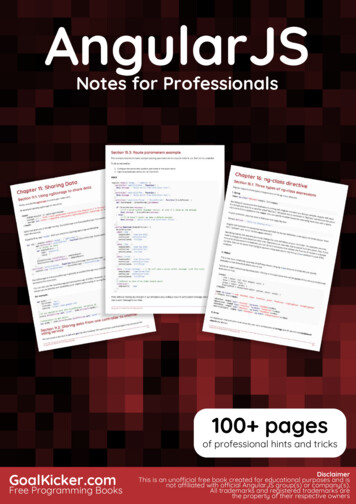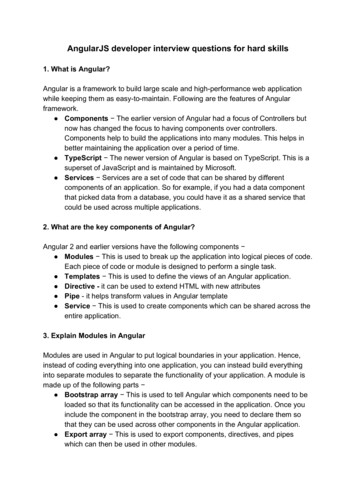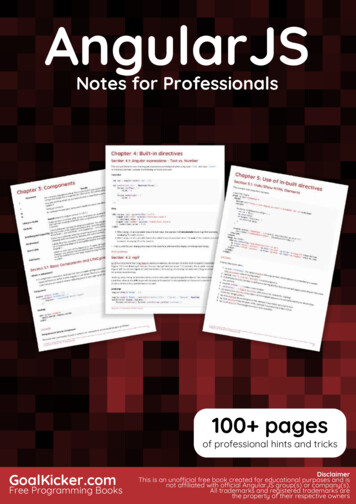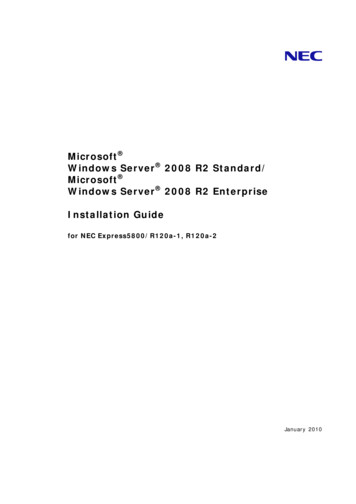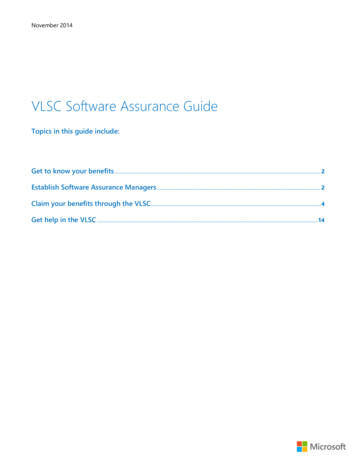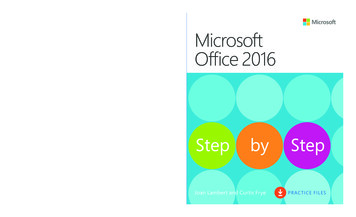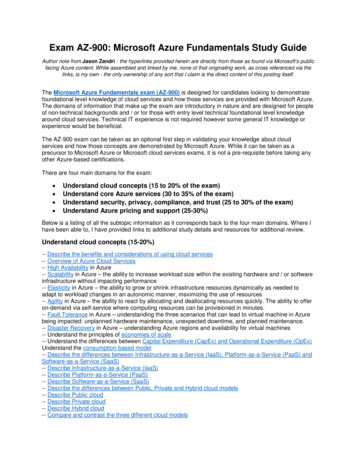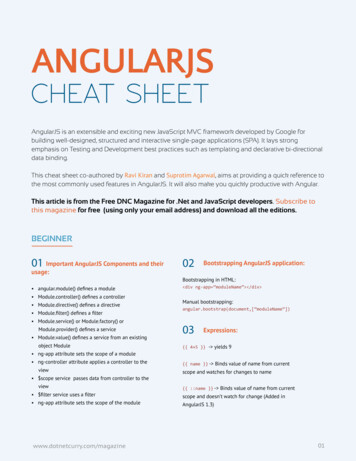
Transcription
ANGULARJSCHEAT SHEETAngularJS is an extensible and exciting new JavaScript MVC framework developed by Google forbuilding well-designed, structured and interactive single-page applications (SPA). It lays strongemphasis on Testing and Development best practices such as templating and declarative bi-directionaldata binding.This cheat sheet co-authored by Ravi Kiran and Suprotim Agarwal, aims at providing a quick reference tothe most commonly used features in AngularJS. It will also make you quickly productive with Angular.This article is from the Free DNC Magazine for .Net and JavaScript developers. Subscribe tothis magazine for free (using only your email address) and download all the editions.BEGINNER01 Important AngularJS Components and theirusage:02Bootstrapping AngularJS application:Bootstrapping in HTML: angular.module() defines a module Module.controller() defines a controller Module.directive() defines a directive Module.filter() defines a filter Module.service() or Module.factory() orModule.provider() defines a service Module.value() defines a service from an existingobject Module div ng-app ”moduleName” /div Manual eName”])03Expressions:{{ 4 5 }} - yields 9 ng-app attribute sets the scope of a module ng-controller attribute applies a controller to theview scope service passes data from controller to theview filter service uses a filter ng-app attribute sets the scope of the modulewww.dotnetcurry.com/magazine{{ name }} - Binds value of name from currentscope and watches for changes to name{{ ::name }} - Binds value of name from currentscope and doesn’t watch for change (Added inAngularJS 1.3)01
04Module:Create a module named myModule1 that depends onmyModule2 and ule2”,“myModule2”])svc.addCity function(city){cities.push(city);};svc.getCities function(){return cities;}});Get reference to the module myModule1angular.module(“myModule1”)05The members added to instance of the service are visible to theoutside world. Others are private to the service. Services areDefining a Controller and using it:singletons, i.e. only one instance of the service is created in thelifetime of an AngularJS application.i. With yModule”).function( scope,){factory(“sampleFactory”, function(){//Members to be used in view for bindingvar cities [“New Delhi”, “Mumbai”, scope.city ”Hyderabad”;“Kolkata”, “Chennai”];});function addCity(city){cities.push(city);}function getCities(){return cities;}In the view:return{getCities: getCities, div ng-controller ”SampleController” addCity:addCity !-- Template of the view with binding};expressions using members of scope -- }); div {{city}} /div /div A factory is a function that returns an object. The membersii. Controller as syntax:that are not added to the returning object, remain privateto the factory. The factory function is executed once and theresult is stored. Whenever an application asks for a factory, theangular.module(“myModule”).application returns the same object. This behavior makes thecontroller(“SampleController”, function(){factory a singleton.var controllerObj this;//Members to be used on view for bindingcontrollerObj.city ”Hyderabad”;Value:});08In the view: div ng-controller ”SampleController as ctrl” div {{ctrl.city}} /div /div 06Defining a mpleValue”, {cities : [“New Delhi”, “Mumbai”, “Kolkata”,“Chennai”],addCity: function(city){cities.push(city);},getCities: function(){return cities;}});A value is a simple JavaScript object. It is created just once, sovalue is also a singleton. Values can’t contain private members.angular.module(“myModule”).All members of a value are public.service(“sampleService”, function(){var svc this;var cities [“New Delhi”, “Mumbai”,“Kolkata”, “Chennai”];02www.dotnetcurry.com/magazine
09Constant:application. Services, Factories and values are not availablefor config block as they are not created by this time. Onlyangular.module(“myModule”). providers and constants are accessible inside the config block.constant(“sampleConstant”,{pi: Math.PI});Config block is executed only once in the lifetime of an Angularapplication.A constant is also like a value. The difference is, a constant canbe injected into config blocks, but a value cannot be injected.1012Run function( anyservices, factories plication is configured. Now inside runprovider(“samplePrd”, function(){block”);this.initCities function(){});console.log(“Initializing Cities ”);};Run block is used to initialize certain values for furtherthis. get function(){var cities [“New Delhi”, “Mumbai”,“Kolkata”, “Chennai”];function addCity(city){cities.push(city);}function getCities(){return cities;}return{ getCities: getCities,addCity:addCity};}});A provider is a low level recipe. The get() method of theprovider is registered as a factory. Providers are availableuse, register global events and anything that needs to run atthe beginning of the application. Run block is executed afterconfig block, and it gets access to services, values and factories.Run block is executed only once in the lifetime of an odule”).filter(“dollarToRupeee”, function(){return function(val){return “Rs. “ val * 60;};});to config blocks and other providers. Once applicationconfiguration phase is completed, access to providers isUsage:prevented. span {{price dollarToRupee}} /span After the configuration phase, the get() method of theFilters are used to extend the behavior of binding expressionsproviders are executed and they are available as factories.and directives. In general, they are used to format values or toServices, Factories and values are wrapped inside provider withapply certain conditions. They are executed whenever the value get() method returning the actual logic implemented insidebound in the binding expression is updated.the provider.11Config on(samplePrdProvider, og(sampleConstant.pi);});Config block runs as soon as a module is loaded. As the nameitself suggests, the config block is used to configure le.directive(“directiveName”, function(injectables) {return {restrict: “A”,template: “ div /div ”,templateUrl: “directive.html”,replace: false,transclude: false,scope: false,03
require: [“someOtherDirective”],controller: function( scope, element, attrs, transclude, otherInjectables) { . },link: function postLink(scope, iElement,iAttrs) { . },priority: 0,terminal: false,compile: function compile(tElement, tAttrs,transclude) {return {pre: function preLink(scope, iElement,iAttrs, controller) { . },post: function postLink(scope,iElement, iAttrs, controller) { . }}}};});Directives add the capability of extending HTML. They are themost complex and the most important part of AngularJS. Adirective is a function that returns a special object, generallytermed as Directive Definition Object. The Directive DefinitionObject is composed of several options as shown in the abovesnippet. Following is a brief note on them: restrict: Used to specify how a directive can be used. Possiblevalues are: E (element), A (Attribute), C (Class) and M (Comment).Default value is A template: HTML template to be rendered in the directive templateUrl: URL of the file containing HTML template of theof the current directive. controller: Controller for the directive. Can be used tomanipulate values on scope or as an API for the currentdirective or a directive requiring the current directive priority: Sets priority of a directive. Default value is 0.Directive with higher priority value is executed before adirective with lower priority terminal: Used with priority. If set to true, it stops executionof directives with lower priority. Default is false link: A function that contains core logic of the directive.It is executed after the directive is compiled. Gets accessto scope, element on which the directive is applied (jqLiteobject), attributes of the element containing the directive andcontroller object. Generally used to perform DOM manipulationand handling events compile: A function that runs before the directive is compiled.Doesn’t have access to scope as the scope is not created yet.Gets an object of the element and attributes. Used to performDOM of the directive before the templates are compiled andbefore the directive is transcluded. It returns an object with twolink functions:o pre link: Similar to the link function, but it is executedbefore the directive is compiled. By this time, transclusion isappliedelement replace: Boolean value denoting if the directive element is too post link: Same as link function mentioned above15Most used built-in directives:be replaced by the template. Default value is false. transclude: Boolean value that says if the directive should ng-app: To bootstrap the applicationpreserve the HTML specified inside directive element afterrendering. Default is false ng-controller: To set a controller on a view scope: Scope of the directive. It may be same as the scope of ng-view: Indicates the portion of the page to besurrounding element (default or when set to false), inheritedupdated when route changesfrom scope of the surrounding element (set to true) or anisolated scope (set to {}) ng-show / ng-hide: Shows/hides the content withinthe directive based on boolean equivalent of value require: A list of directive that the current directive needs.assignedCurrent directive gets access to controller of the requireddirective. An object of the controller is passed into link function04 ng-if: Places or removes the DOM elements underwww.dotnetcurry.com/magazine
this directive based on boolean equivalent of valueassigned ng-model: Enables two-way data binding on anyinput controls and sends validity of data in the inputcontrol to the enclosing form16AngularJS Naming Conventions While naming a file say an authentication controller,end it with the object suffix. For eg: an authenticationcontroller can be renamed as auth–controller.js.Similar service can be called as auth-service.js,directive as auth-directive.js and a filter as auth-filter.js ng-class: Provides an option to assign value of Create meaningful & short lower case file names that alsoa model to CSS, conditionally apply styles and usereflect the folder structure. For eg: if we have a login controllermultiple models for CSS declarativelyinside the login folder which is used for creating users, call itlogin-create-controller.js ng-repeat: Loops through a list of items and copiesthe HTML for every record in the collection Similar a testing naming convention that you could followis if the filename is named as login-directive.js, call its test file ng-options: Used with HTML select element tocounterpart as login-directive test.js. Similarly a test file forrender options based on data in a collectionlogin-service.js can be called as login-service test.jsUse a workflow management tool like Yeoman plugin for ng-href: Assigns a model as hyperlink to an anchorAngular that automates a lot of these routines and much moreelementfor you. Also look at ng-boilerplate to get an idea of the projectand directory structure. ng-src: Assigns a model to source of an imageelement17 ng-click: To handle click event on any elementAngularJS has a built-in dependency injector that keeps trackDependency Injection:of all components (services, values, etc.) and returns instances ng-change: Requires ng-model to be presentof needed components using dependency injection. Angular’salong with it. Calls the event handler or evaluates thedependency injector works based on names of the components.assigned expression when there is a change to valueof the modelA simple case of dependency injection: ng-form: Works same as HTML form and allowsmyModule.controller(“MyController”, function( scope, window, myService){});nesting of forms ng-non-bindable: Prevents AngularJS fromcompiling or binding the contents of the current DOMelement ng-repeat-start and ng-repeat-end: Repeats top-levelattributes ng-include: Loads a partial viewHere, scope, window and myService are passed into thecontroller through dependency injection. But the above codewill break when the code is minified. Following approach solvesit:myModule.controller(“MyController”, [“ scope”,“ window”, “myService”,function( scope, window, myService){}]); ng-init: Used to evaluate an expression in the current scope ng-switch conditionally displays elements ng-cloak to prevent Angular HTML to load beforebindings are applied.www.dotnetcurry.com/magazine05
1821RoutesSome useful utility functions angular.copy - Creates a deep copy of sourceRoutes in AngularJS application are defined using routeProvider. We can define a list of routes and set one ofthe routes as default using otherwise() method; this route angular.extend - Copy methods and properties from onewill respond when the URL pattern doesn’t match any of theobject to anotherconfigured patterns. angular.element - Wraps a raw DOM element or HTML stringas a jQuery element19 angular.equals - Determines if two objects or two values areRegistering routes:equivalentmyModule.config(function( routeProvider){ plates/home.html”,controller: “HomeController”}).when(“/details/:id”, ”ListController”}).otherwise({redirectTo: “/home”});}); angular.forEach - Enumerate the content of a collection angular.toJson - Serializes input into a JSON-formatted string angular.fromJson - Deserializes a JSON string angular.identity - Returns its first argument angular.isArr
This cheat sheet co-authored by Ravi Kiran and Suprotim Agarwal, aims at providing a quick reference to the most commonly used features in AngularJS. It will also make you quickly productive with Angular. This article is from the Free DNC Magazine for .Net and JavaScript developers. Subscribe to
